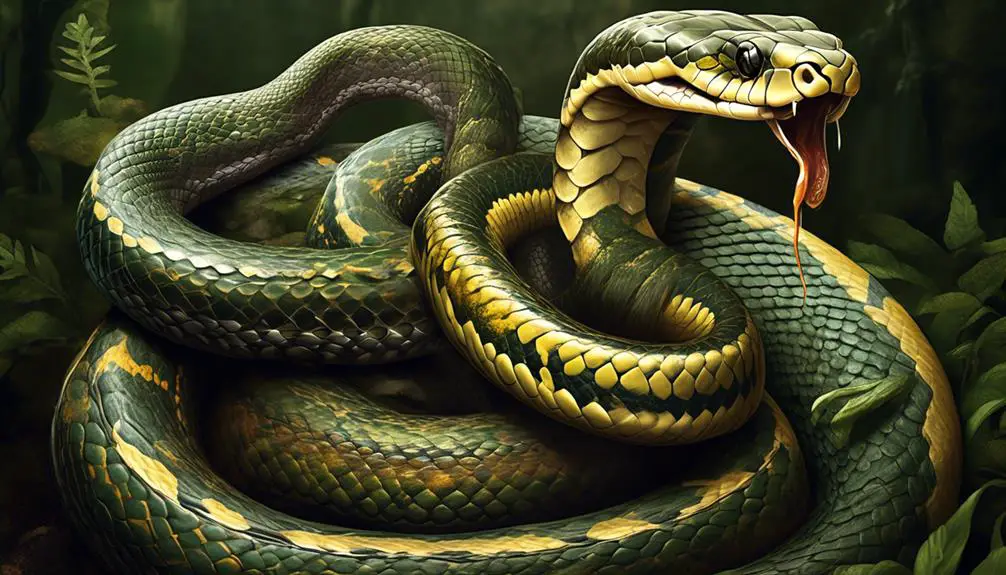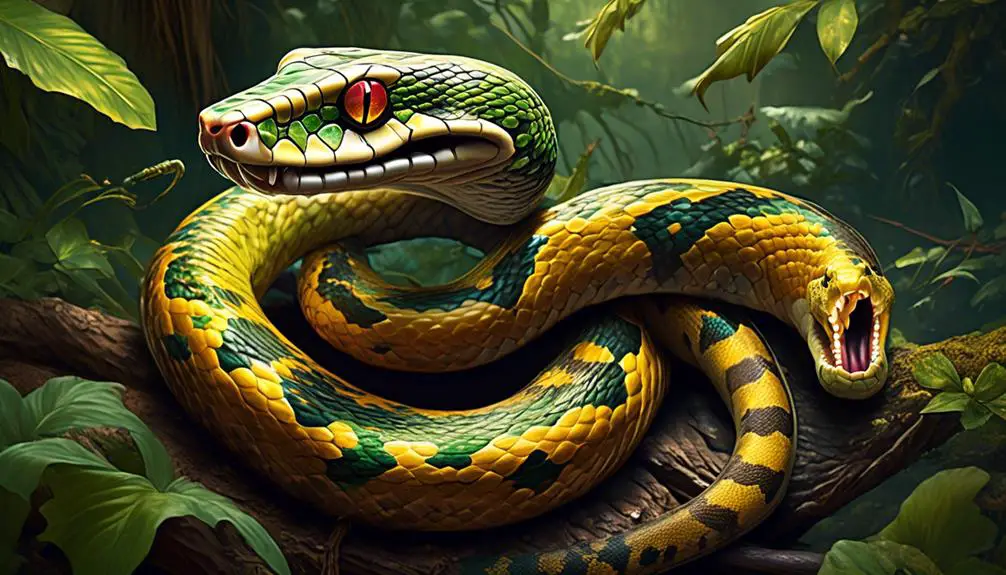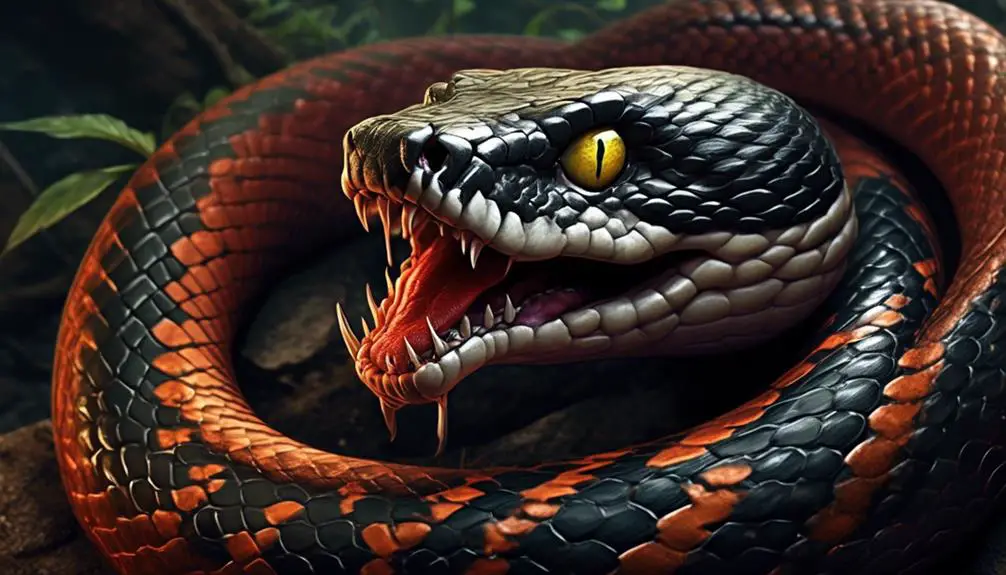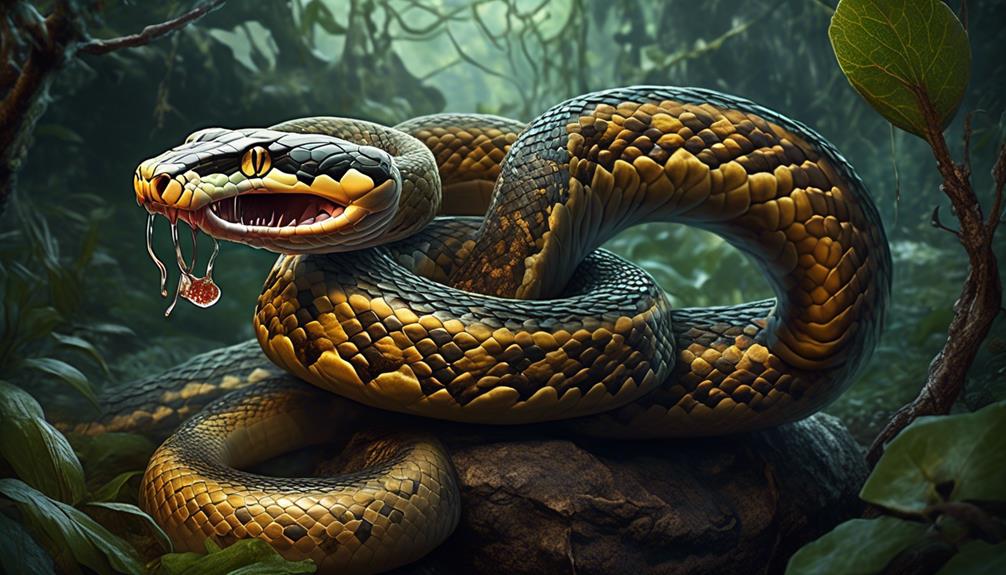Have you ever wondered why snakes, with their seemingly effortless slithering movement, do not have any legs? It’s a curious juxtaposition – a creature that moves so gracefully, yet lacks the appendages we typically associate with mobility.
But what if there’s more to the story? What if snakes actually did have legs at some point in their evolutionary history? In this discussion, we will explore the intriguing world of snake anatomy and evolution, and uncover the fascinating truth about snake legs, or the lack thereof.
So, prepare to be amazed as we unravel the mysteries of these limbless reptiles and discover the surprising secrets hidden within their serpentine bodies.
Snake Anatomy and Evolution

Snakes, as limbless reptiles belonging to the suborder Serpentes, have evolved through the process of gradual leg loss and modification, resulting in their unique ability to move by slithering using their abdominal muscles. They lack limbs, wings, external ears, eyelids, and vocal cords.
Pythons and boas, large snake species, show evidence of their legged ancestors with vestigial legs, consisting of two small hind leg bones buried in their muscles. The Sonic hedgehog (SHH) gene, responsible for limb development, is still present in pythons and boas. However, it operates for only 24 hours in python and boa embryos, resulting in the development of spikes that aid in mating and tree climbing.
Snakes lost their legs about 150 million years ago, but fossil records suggest that snakes had legs during their first 70 million years of existence. The Najash rionegrina, discovered in 2003, is the first known terrestrial snake with noticeable hind legs, providing further evidence of snakes’ legged past.
Snakes’ leglessness is a result of evolutionary modification, as they gradually grew out of their legs, while their ancestral successors, lizards, continue to rely on their legs for movement.
Snake Diet

Moving on from the discussion of snake anatomy and evolution, let’s now explore the intriguing topic of snake diet. Snakes, being carnivorous reptiles, feed on a variety of prey including rodents, birds, and other reptiles. Some larger snake species can even consume small mammals. A unique ability that snakes possess is the ability to unhinge their jaws, allowing them to swallow prey whole. The frequency of snake feeding depends on factors such as species, size, and metabolism. To give you a clearer picture, here is a table showcasing the diet of some common snake species:
| Snake Species | Prey |
|---|---|
| Ball Python | Small mammals, birds, lizards |
| Corn Snake | Rodents, birds |
| King Cobra | Other snakes, lizards, birds, mammals |
| Garter Snake | Fish, amphibians, insects, earthworms |
| Rattlesnake | Small mammals, birds, lizards |
As you can see, snakes have a diverse diet and play a crucial role in controlling populations of their prey. Their ability to consume such a wide range of animals showcases their adaptability and efficiency as predators.
Venomous and Non-Venomous Snakes

Now let’s delve into the intriguing world of venomous and non-venomous snakes.
Venomous snakes possess specialized fangs and venom glands that allow them to inject venom into their prey, causing paralysis, tissue damage, and even death.
In contrast, non-venomous snakes lack these adaptations and rely on other methods such as constriction or swallowing prey whole.
It’s crucial to be able to identify venomous snakes to avoid potential dangers, as venomous snakebites require immediate medical attention while non-venomous snakebites are generally harmless.
Snake Fangs and Venom
Snake fangs are specialized structures found in venomous and non-venomous snakes, playing a crucial role in their feeding and defense mechanisms. Venomous snakes have long, hollow fangs located in the front of their upper jaw. These fangs are connected to venom glands, which produce and store venom. When the snake strikes and bites its prey, venom is injected through the fangs into the victim’s body. The venom contains toxins that immobilize or kill the prey, making it easier for the snake to consume. In contrast, non-venomous snakes have smaller, solid teeth, which they use to grasp and hold onto their prey. They rely on constriction or swallowing the prey whole to subdue and consume it. The following table provides an overview of the differences between venomous and non-venomous snakes:
| Venomous Snakes | Non-Venomous Snakes |
|---|---|
| Have hollow fangs connected to venom glands | Have smaller, solid teeth |
| Inject venom into prey | Subdue prey through constriction or swallowing |
| Use venom for hunting and defense | Rely on other mechanisms for feeding and defense |
| Require immediate medical attention if bitten | Bites are generally harmless |
| Found in various parts of the world | More widespread distribution |
Snake fangs and venom are fascinating adaptations that have allowed venomous snakes to become efficient predators, while non-venomous snakes have developed alternate strategies for survival. Understanding the differences between venomous and non-venomous snakes is crucial for their conservation and for the safety of humans and other animals that may encounter them.
Identification and Dangers
After examining the fascinating adaptations of snake fangs and venom, the focus now shifts to the crucial topic of identifying and understanding the potential dangers posed by venomous and non-venomous snakes.
Venomous snakes, such as the inland taipan, eastern brown snake, and black mamba, inject venom into their prey through specialized fangs. This venom can cause paralysis, tissue damage, and even death in humans.
Non-venomous snakes, on the other hand, lack these adaptations and rely on constriction or swallowing prey whole. It’s essential to be able to identify venomous snakes to avoid potential dangers. Venomous snakebites require immediate medical attention, while non-venomous snakebites are generally harmless.
Venomous snakes can be found in various parts of the world, while non-venomous snakes are more widespread.
Snake Venom Immunity

Now let’s explore the fascinating world of snake venom immunity.
Snakes, particularly certain species, have developed a remarkable ability to withstand the effects of their own venom. This immunity is achieved through the presence of specialized proteins and enzymes in their bloodstream.
Snake Venom Composition
The composition of snake venom is a complex mixture of proteins, enzymes, and toxins that serve various functions in hunting and defense.
Snake venom is primarily composed of proteins called toxins, which are responsible for the venom’s toxic effects on prey and potential predators. These toxins can disrupt the normal functioning of cells and tissues, causing paralysis, tissue damage, and even death.
Enzymes in snake venom play a crucial role in facilitating the spread of venom through the body, as well as in the breakdown of tissues for easier digestion.
The specific composition of snake venom varies among different snake species, enabling them to target and immobilize their preferred prey.
Understanding the composition of snake venom is essential for developing effective antivenom treatments and studying the evolutionary adaptations of venomous snakes.
Snake Venom Antivenom
Snake venom antivenom, also known as snake venom immunity, is a crucial area of study that focuses on developing treatments to counteract the toxic effects of snake venom. When a snake injects venom into its prey or a human, it can cause severe symptoms such as tissue damage, paralysis, and even death.
However, some snake species have evolved a natural resistance to their own venom. This immunity is achieved through specialized proteins and enzymes in their bloodstream. Snake handlers and researchers who are regularly exposed to snake venom can also develop partial immunity.
Understanding the mechanisms behind snake venom immunity is essential in the development of effective antivenom treatments that can save lives and minimize the harmful effects of snakebites.
Nocturnal Snakes

Nocturnal snakes, with their specialized adaptations for hunting in the dark, play a crucial role in maintaining the balance of ecosystems. These snakes have developed unique features that allow them to thrive during nighttime hours. One of their most notable adaptations is the presence of heat-sensing pits, which enable them to detect the body heat of their prey even in complete darkness. Additionally, nocturnal snakes often have larger eyes compared to their diurnal counterparts, allowing for better low-light vision. Their behavior and hunting strategies differ from diurnal snakes, as they take advantage of the cover of darkness to ambush unsuspecting prey.
To further emphasize the importance of nocturnal snakes, let’s take a closer look at some common nocturnal snake species:
| Species | Habitat |
|---|---|
| Eastern Diamondback Rattlesnake | Forests and grasslands |
| African Rock Python | Savannas and grasslands |
| Black Rat Snake | Woodlands and farmlands |
Nocturnal snakes, such as the ones listed above, are instrumental in controlling rodent populations, which can have significant impacts on agricultural and ecosystem health. By preying on rodents during the night, these snakes help to keep their populations in check and prevent potential damage to crops and other vegetation. Their ability to navigate and hunt effectively in the dark makes them essential players in the intricate web of life.
Snake Reproduction

Reproduction in snakes involves a complex series of events that ensure the continuation of their species. Snakes have a unique reproductive system characterized by internal fertilization and the production of eggs. Unlike mammals, snakes don’t give live birth. Instead, they lay eggs which develop and hatch outside of the mother’s body.
The process of snake reproduction begins with courtship rituals, where males compete for the attention of females. This can involve displays of strength, mating dances, and even combat. Once a male has successfully courted a female, copulation occurs. Snakes have a pair of specialized organs called hemipenes, which are used for sperm transfer.
After copulation, the female snake develops and lays a clutch of eggs. The number of eggs laid varies depending on the species, ranging from a few to several dozen. The eggs are then incubated either internally or externally, depending on the species. Some snakes retain the eggs inside their bodies until they’re ready to hatch, while others lay the eggs in suitable environments.
During incubation, the eggs are kept warm and protected until they hatch. This can be achieved through various methods such as burying the eggs underground or wrapping around them to provide heat. The incubation period varies depending on the species and environmental conditions.
Once the eggs hatch, the young snakes emerge and begin their independent lives. Snake reproduction is a remarkable process that ensures the survival and diversity of these fascinating creatures.
Snake Conservation and Threats

Conservation efforts are crucial for ensuring the survival and protection of snake species and their habitats. Snakes play important roles in ecosystems as both predators and prey, and their loss can disrupt the balance of these ecosystems.
Unfortunately, snakes face numerous threats that put their populations at risk. Habitat destruction is a major concern, as it leads to the loss of suitable habitats for snakes to live and reproduce. Deforestation, urbanization, and agricultural expansion all contribute to habitat loss. Additionally, pollution, including water and air pollution, can negatively impact snake populations.
Climate change is another significant threat, as it alters temperature and precipitation patterns, affecting the habitats and prey availability of snakes. Illegal wildlife trade also poses a threat to snakes, as they’re often targeted for their skins, meat, and use in traditional medicine. Invasive species can also harm snake populations by competing for resources or preying on them directly.
It’s essential to implement conservation measures, such as habitat restoration and protection, enforcement of wildlife trade regulations, and public education to raise awareness about the importance of snakes and their conservation. Only through these efforts can we ensure the survival and protection of snake species for future generations.

Erzsebet Frey (Eli Frey) is an ecologist and online entrepreneur with a Master of Science in Ecology from the University of Belgrade. Originally from Serbia, she has lived in Sri Lanka since 2017. Eli has worked internationally in countries like Oman, Brazil, Germany, and Sri Lanka. In 2018, she expanded into SEO and blogging, completing courses from UC Davis and Edinburgh. Eli has founded multiple websites focused on biology, ecology, environmental science, sustainable and simple living, and outdoor activities. She enjoys creating nature and simple living videos on YouTube and participates in speleology, diving, and hiking.

